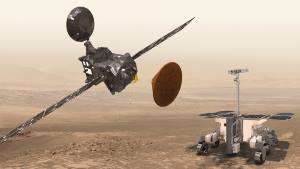
Back إكسو مارس Arabic Екзомарс Bulgarian ExoMars BS ExoMars Catalan ئێگزۆمارس CKB ExoMars Czech ExoMars Danish ExoMars German ExoMars Greek ExoMars Spanish
 Artist's illustration of ExoMars's Trace Gas Orbiter (left), Schiaparelli lander (middle), and rover (right) | |
| Mission type | Mars reconnaissance |
|---|---|
| Operator | ESA · SRI RAS (IKI RAN) (formerly) |
| Website | www iki |
| Mission duration | Trace Gas Orbiter: 8 years, 2 months and 17 days (in progress) Schiaparelli: 7 months |
 ExoMars ESA mission insignia | |
ExoMars (Exobiology on Mars) is an astrobiology programme of the European Space Agency (ESA) and the Russian space agency (Roscosmos).
The goals of ExoMars are to search for signs of past life on Mars,[1][2] investigate how the Martian water and geochemical environment varies, investigate atmospheric trace gases and their sources and, by doing so, demonstrate the technologies for a future Mars sample-return mission.[3]
The first part of the programme is a mission launched in 2016 that placed the Trace Gas Orbiter into Mars orbit and released the Schiaparelli EDM lander. The orbiter is operational but the lander crashed on the planet's surface. The second part of the programme was planned to launch in July 2020, when the Kazachok lander would have delivered the Rosalind Franklin rover on the surface, supporting a science mission that was expected to last into 2022 or beyond.[4][5][6] On 12 March 2020, it was announced that the second mission was being delayed to 2022 as a result of problems with the parachutes, which could not be resolved in time for the launch window.
The Trace Gas Orbiter (TGO) and a test stationary lander called Schiaparelli were launched on 14 March 2016.[7] TGO entered Mars orbit on 19 October 2016 and proceeded to map the sources of methane (CH4) and other trace gases present in the Martian atmosphere that could be evidence for possible biological or geological activity. The TGO features four instruments and will also act as a communications relay satellite. The Schiaparelli experimental lander separated from TGO on 16 October and was maneuvered to land in Meridiani Planum, but it crashed on the surface of Mars.[8] The landing was designed to test new key technologies to safely deliver the subsequent rover mission.[9]
In June 2023, a Roscosmos lander named Kazachok ("little Cossack", referring to a folk dance),[10] was due to deliver the ESA Rosalind Franklin rover to the Martian surface.[5][11][12][13] The rover would also include some Roscosmos built instruments. The second mission operations and communications would have been led by ALTEC's Rover Control Centre in Italy.[14]
On 17 March 2022, ESA suspended the mission due to the ongoing invasion of Ukraine by Russia.[15] ESA expects that a restart of the mission, using a new non-Russian landing platform, is unlikely to launch before 2028.[16]
The mission received additional funding to restart and deliver complete the mission. The award went to Thales Alenia Space and scheduled for 2028.[17]
- ^ Chang, Kenneth (12 September 2016). "Visions of Life on Mars in Earth's Depths". The New York Times. Retrieved 12 September 2016.
- ^ Vago, Jorge L.; et al. (2017). "Habitability on Early Mars and the Search for Biosignatures with the ExoMars Rover". Astrobiology. 17 (6–7): 471–510. Bibcode:2017AsBio..17..471V. doi:10.1089/ast.2016.1533. PMC 5685153. PMID 31067287.
- ^ "The ExoMars Programme 2016–2018". European Space Agency (ESA). 2015. Retrieved 16 March 2016.
- ^ Chang, Kenneth (19 October 2016). "ExoMars Mission to Join Crowd of Spacecraft at Mars". The New York Times. Retrieved 19 October 2016.
- ^ a b "ExoMars: ESA and Roscosmos set for Mars missions". European Space Agency (ESA). 14 March 2013.
- ^ Amos, Jonathan (18 June 2013). "Europe". BBC News.
- ^ Cite error: The named reference
NYT-20160314was invoked but never defined (see the help page). - ^ Chang, Kenneth (21 October 2016). "Dark Spot in Mars Photo Is Probably Wreckage of European Spacecraft". The New York Times. Retrieved 21 October 2016.
- ^ Katz, Gregory (27 March 2014). "2018 mission: Mars rover prototype unveiled in UK". Excite News. AP News. Archived from the original on 7 April 2014. Retrieved 29 March 2014.
- ^ Wall, Mike (21 March 2019). "Meet 'Kazachok': Landing Platform for ExoMars Rover Gets a Name – In 2021, Rosalind Franklin will roll off Kazachok onto the red dirt of Mars". Space.com. Retrieved 21 March 2019.
- ^ "N° 11–2016: Second ExoMars mission moves to next launch opportunity in 2020" (Press release). ESA. 2 May 2016. Retrieved 2 May 2016.
- ^ Amos, Jonathan (15 March 2012). "Europe still keen on Mars missions". BBC News.
- ^ de Selding, Peter B. (15 March 2012). "ESA Ruling Council OKs ExoMars Funding". Space News. Archived from the original on 6 December 2012.
- ^ "ALTEC's role in ExoMars". ALTEC website. Archived from the original on 13 July 2018. Retrieved 18 February 2016.
- ^ "ExoMars suspended". www.esa.int. Retrieved 17 March 2022.
- ^ Foust, Jeff (3 May 2022). "ExoMars official says launch unlikely before 2028". SpaceNews. Retrieved 5 May 2022.
- ^ Foust, Jeff (10 April 2024). "ESA awards contract to Thales Alenia Space to restart ExoMars". SpaceNews. Retrieved 11 April 2024.
© MMXXIII Rich X Search. We shall prevail. All rights reserved. Rich X Search